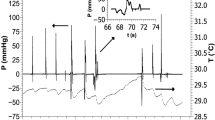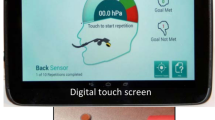Abstract
We describe a novel device and method for real-time measurement of lingual–palatal pressure and automatic identification of the oral transfer phase of deglutition. Clinical measurement of the oral transport phase of swallowing is a complicated process requiring either placement of obstructive sensors or sitting within a fluoroscope or articulograph for recording. Existing detection algorithms distinguish oral events with EMG, sound, and pressure signals from the head and neck, but are imprecise and frequently result in false detection. We placed seven pressure sensors on a molded mouthpiece fitting over the upper teeth and hard palate and recorded pressure during a variety of swallow and non-swallow activities. Pressure measures and swallow times from 12 healthy and 7 Parkinson’s subjects provided training data for a time-delay artificial neural network to categorize the recordings as swallow or non-swallow events. User-specific neural networks properly categorized 96 % of swallow and non-swallow events, while a generalized population-trained network was able to properly categorize 93 % of swallow and non-swallow events across all recordings. Lingual–palatal pressure signals are sufficient to selectively and specifically recognize the initiation of swallowing in healthy and dysphagic patients.










Similar content being viewed by others
Explore related subjects
Discover the latest articles and news from researchers in related subjects, suggested using machine learning.References
Medda BK, Kern M, Ren J, Xie P, Ulualp SO, Lang IM, Shaker R. Relative contribution of various airway protective mechanisms to prevention of aspiration during swallowing. Am J Physiol Gastrointest Liver Physiol. 2003;284(6):G933–9.
Heuschmann PU, Kolominsky-Rabas PL, Misselwitz B, Hermanek P, Leffmann C, Janzen RWC, Rother J, Buecker-Nott H-J, Berger K. Predictors of in-hospital mortality and attributable risks of death after ischemic stroke: the German Stroke Registers Study Group. Arch Intern Med. 2004;164(16):1761–8.
Troche MS, Okun MS, Rosenbek JC, Musson N, Fernandez HH, Rodriguez R, Romrell J, Pitts T, Wheeler-Hegland KM, Sapienza CM. Aspiration and swallowing in Parkinson disease and rehabilitation with EMST: a randomized trial. Neurology. 2010;75(21):1912–9.
Miller AJ. Neurophysiological basis of swallowing. Dysphagia. 1986;1(2):91–100.
Yoshida M, Kikutani T, Tsuga K, Utanohara Y, Hayashi R, Akagawa Y. Decreased tongue pressure reflects symptom of dysphagia. Dysphagia. 2006;21(1):61–5.
Jean A. Control of the central swallowing program by inputs from the peripheral receptors. A review. J Auton Nerv Syst. 1984;10(3):225–33.
Jean A. Brain stem control of swallowing: neuronal network and cellular mechanisms. Physiol Rev. 2001;81(2):929–69.
Martin-Harris B, Brodsky MB, Price CC, Michel Y, Walters B. Temporal coordination of pharyngeal and laryngeal dynamics with breathing during swallowing: single liquid swallows. J Appl Physiol. 2003;94(5):1735–43.
Carnaby GD, Harenberg L. What is ‘Usual Care’ in dysphagia rehabilitation: a survey of USA dysphagia practice patterns. Dysphagia. 2013. doi:10.1007/s00455-013-9467-8.
Blitzer A, Brin M. Neurologic disorders of the larynx, vol. 2. New York: Thieme; 2009. p. 256.
Humbert IA, Poletto CJ, Saxon KG, Kearney PR, Ludlow CL. The effect of surface electrical stimulation on vocal fold position. Laryngoscope. 2008;118(1):14–9.
Broniatowski M, Grundfest-Broniatowski S, Hadley AJ, Shah NS, Barbu AM, Phillipbar SA, Strohl KP, Tucker HM, Tyler DJ. Improvement of respiratory compromise through abductor reinnervation and pacing in a patient with bilateral vocal fold impairment. Laryngoscope. 2010;120(1):76–83.
Tyler D. Neuroprostheses for management of dysphagia resulting from cerebrovascular disorders. Oper Neuromodul. 2007;97(Pt 1):293–304.
Peckham PH, Knutson JS. Functional electrical stimulation for neuromuscular applications. Annu Rev Biomed Eng. 2005;7:327–60.
Hadley AJ, Kolb I, Tyler DJ. Laryngeal elevation by selective stimulation of the hypoglossal nerve. J Neural Eng. 2013;10(4):046013.
Hadley AJ, Thompson P, Kolb I, Hahn EC, Tyler DJ. Targeted transtracheal stimulation for vocal fold closure. Dysphagia. 2014. doi:10.1007/s00455-014-9517-x.
Burnett TA, Mann EA, Stoklosa JB, Ludlow CL. Self-triggered functional electrical stimulation during swallowing. J Neurophysiol. 2005;94(6):4011–8.
Broniatowski M, Moore NZ, Grundfest-Broniatowski S, Tucker HM, Lancaster E, Krival K, Hadley AJ, Tyler DJ. Paced glottic closure for controlling aspiration pneumonia in patients with neurologic deficits of various causes. Ann Otol Rhinol Laryngol. 2010;119(3):141–9.
Garliner D. Swallow right–or else!. St. Louis: W. H. Green; 1979. p. 122.
Das A, Reddy NP, Narayanan J. Hybrid fuzzy logic committee neural networks for recognition of swallow acceleration signals. Comput Methods Programs Biomed. 2001;64(2):87–99.
Amft O, Troster G. Methods for detection and classification of normal swallowing from muscle activation and sound. Pervasive Health Conf Workshop. 2006;2006:1–10.
Li C-Y, Chen Y-C, Chen W-J, Huang P, Chu H. Sensor-embedded teeth for oral activity recognition. 2013.
Sazonov ES, Makeyev O, Schuckers S, Lopez-Meyer P, Melanson EL, Neuman MR. Automatic detection of swallowing events by acoustical means for applications of monitoring of ingestive behavior. IEEE Trans Biomed Eng. 2010;57(3):626–33.
Wheeler KM, Chiara T, Sapienza CM. Surface electromyographic activity of the submental muscles during swallow and expiratory pressure threshold training tasks. Dysphagia. 2007;22(2):108–16.
Nicosia MA, Hind JA, Roecker EB, Carnes M, Doyle J, Dengel GA, Robbins J. Age effects on the temporal evolution of isometric and swallowing pressure. J Gerontol A Biol Sci Med Sci. 2000;55(11):M634–40.
Kothari M, Svensson P, Jensen J, Holm TD, Nielsen MS, Mosegaard T, Nielsen JF, Ghovanloo M, Baad-Hansen L. Tongue controlled computer game: a new approach for rehabilitation of tongue motor function. Arch Phys Med Rehabil. 2013. doi:10.1016/j.apmr.2013.08.008.
Pouderoux P, Kahrilas PJ. Deglutitive tongue force modulation by volition, volume, and viscosity in humans. Gastroenterology. 1995;108(5):1418–26.
Ono T, Hori K, Nokubi T. Pattern of tongue pressure on hard palate during swallowing. Dysphagia. 2004;19(4):259–64.
Kieser J, Singh B, Swain M, Ichim I, Waddell JN, Kennedy D, Foster K, Livingstone V. Measuring intraoral pressure: adaptation of a dental appliance allows measurement during function. Dysphagia. 2008;23(3):237–43.
Farland G. Under pressure: generic and individual intra-oral pressure profiles in liquid swallows. Dunedin: University of Otago; 2011.
Pulliam CL. Simultaneous multi-joint myoelectric control of transradial prostheses. Dissertation, Case Western Reserve University, Cleveland; 2013.
Crary MA, Mann GDC, Groher ME. Initial psychometric assessment of a functional oral intake scale for dysphagia in stroke patients. Arch Phys Med Rehabil. 2005;86(8):1516–20.
Hori K, Ono T, Tamine K, Kondo J, Hamanaka S, Maeda Y, Dong J, Hatsuda M. Newly developed sensor sheet for measuring tongue pressure during swallowing. J Prosthodont Res. 2009;53(1):28–32.
Hamlet SL. Dynamic aspects of lingual propulsive activity in swallowing. Dysphagia. 1989;4(3):136–45.
Acknowledgments
This work was funded through a Grant from the Coulter Foundation through the Case-Coulter Translational Research Partnership.
Conflict of interest
The senior author has an equity stake in Bear Software, LLC, which has commercial interest related to subject matter discussed in the paper.
Author information
Authors and Affiliations
Corresponding author
Rights and permissions
About this article
Cite this article
Hadley, A.J., Krival, K.R., Ridgel, A.L. et al. Neural Network Pattern Recognition of Lingual–Palatal Pressure for Automated Detection of Swallow. Dysphagia 30, 176–187 (2015). https://doi.org/10.1007/s00455-014-9593-y
Received:
Accepted:
Published:
Issue Date:
DOI: https://doi.org/10.1007/s00455-014-9593-y




